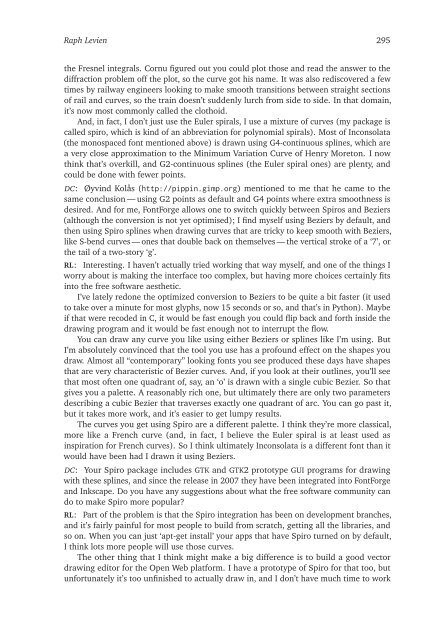Raph Levien - TUG
Raph Levien - TUG
Raph Levien - TUG
Create successful ePaper yourself
Turn your PDF publications into a flip-book with our unique Google optimized e-Paper software.
<strong>Raph</strong> <strong>Levien</strong> 295<br />
the Fresnel integrals. Cornu figured out you could plot those and read the answer to the<br />
diffraction problem off the plot, so the curve got his name. It was also rediscovered a few<br />
times by railway engineers looking to make smooth transitions between straight sections<br />
of rail and curves, so the train doesn’t suddenly lurch from side to side. In that domain,<br />
it’s now most commonly called the clothoid.<br />
And, in fact, I don’t just use the Euler spirals, I use a mixture of curves (my package is<br />
called spiro, which is kind of an abbreviation for polynomial spirals). Most of Inconsolata<br />
(the monospaced font mentioned above) is drawn using G4-continuous splines, which are<br />
a very close approximation to the Minimum Variation Curve of Henry Moreton. I now<br />
think that’s overkill, and G2-continuous splines (the Euler spiral ones) are plenty, and<br />
could be done with fewer points.<br />
DC: Øyvind Kolås (http://pippin.gimp.org) mentioned to me that he came to the<br />
same conclusion — using G2 points as default and G4 points where extra smoothness is<br />
desired. And for me, FontForge allows one to switch quickly between Spiros and Beziers<br />
(although the conversion is not yet optimised); I find myself using Beziers by default, and<br />
then using Spiro splines when drawing curves that are tricky to keep smooth with Beziers,<br />
like S-bend curves — ones that double back on themselves — the vertical stroke of a ‘7’, or<br />
the tail of a two-story ‘g’.<br />
RL: Interesting. I haven’t actually tried working that way myself, and one of the things I<br />
worry about is making the interface too complex, but having more choices certainly fits<br />
into the free software aesthetic.<br />
I’ve lately redone the optimized conversion to Beziers to be quite a bit faster (it used<br />
to take over a minute for most glyphs, now 15 seconds or so, and that’s in Python). Maybe<br />
if that were recoded in C, it would be fast enough you could flip back and forth inside the<br />
drawing program and it would be fast enough not to interrupt the flow.<br />
You can draw any curve you like using either Beziers or splines like I’m using. But<br />
I’m absolutely convinced that the tool you use has a profound effect on the shapes you<br />
draw. Almost all “contemporary” looking fonts you see produced these days have shapes<br />
that are very characteristic of Bezier curves. And, if you look at their outlines, you’ll see<br />
that most often one quadrant of, say, an ‘o’ is drawn with a single cubic Bezier. So that<br />
gives you a palette. A reasonably rich one, but ultimately there are only two parameters<br />
describing a cubic Bezier that traverses exactly one quadrant of arc. You can go past it,<br />
but it takes more work, and it’s easier to get lumpy results.<br />
The curves you get using Spiro are a different palette. I think they’re more classical,<br />
more like a French curve (and, in fact, I believe the Euler spiral is at least used as<br />
inspiration for French curves). So I think ultimately Inconsolata is a different font than it<br />
would have been had I drawn it using Beziers.<br />
DC: Your Spiro package includes GTK and GTK2 prototype GUI programs for drawing<br />
with these splines, and since the release in 2007 they have been integrated into FontForge<br />
and Inkscape. Do you have any suggestions about what the free software community can<br />
do to make Spiro more popular?<br />
RL: Part of the problem is that the Spiro integration has been on development branches,<br />
and it’s fairly painful for most people to build from scratch, getting all the libraries, and<br />
so on. When you can just ‘apt-get install’ your apps that have Spiro turned on by default,<br />
I think lots more people will use those curves.<br />
The other thing that I think might make a big difference is to build a good vector<br />
drawing editor for the Open Web platform. I have a prototype of Spiro for that too, but<br />
unfortunately it’s too unfinished to actually draw in, and I don’t have much time to work

















